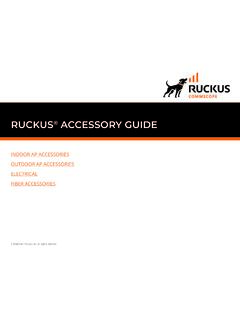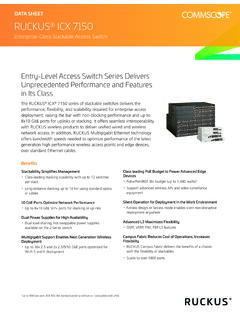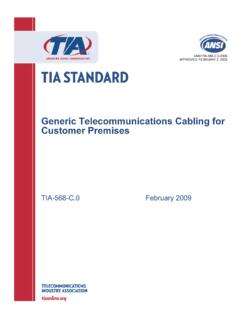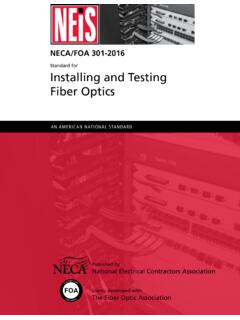Transcription of Technical Document: Power Separation ... - CommScope
1 SYSTIMAX SOLUTIONS Power Separation Guidelines for SYSTIMAX Installations July 20202 SYSTIMAX Solutions Power Separation Guidelines for SYSTIMAX General These guidelines are based on extensive testing and modeling performed by CommScope Labs and by standards committees (especially by TIA in the US). The guidelines outline the minimum requirements for registration of SYSTIMAX installations for the 25-Year Extended Product Warranty and Applications Assurance Program. The exception is for installations with SYSTIMAX x297/x298 cables where the guidelines outline in Section shall apply. Unless otherwise stated, the Power cables are assumed to be local or national safety regulations take precedence whenever their required Separation distances are larger than those specified in this document. For example: In the UK, if no mechanical divider is present between the data and Power cables, BS 6701 requires a minimum Separation distance of 50 mm (2 in) for voltages less than 600 In the USA, Article of NEC Ed 2002 states the following for Class 1 circuits: Communications wires and cables shall be separated at least 50 mm (2 in) from conductors of any electric light, Power , Class 1, non- Power -limited fire alarm, or medium Power network-powered broadband communications circuits.
2 Exception No. 1: Where either (1) all of the conductors of the electric light, Power , Class 1, non- Power -limited fire alarm, and medium Power network-powered broadband communications circuits are in a raceway or in metal-sheathed, metal-clad, nonmetallic-sheathed, Type AC, or Type UF cables, or (2) all of the conductors of communications circuits are encased in raceway. Exception No. 2: Where the communications wires and cables are permanently separated from the conductors of electric light, Power , Class 1, non- Power -limited fire alarm, and medium Power network-powered broadband communications circuits by a continuous and firmly fixed non-conductor, such as porcelain tubes or flexible tubing, in addition to the insulation on the the US, ANSI/TIA-942 Telecommunications Infrastructure Standard for Data Centers and ANSI/TIA-1005 Telecommunications Infrastructure Standard for Industrial premises provide Power Separation requirements in Clause and Clause respectively.
3 These requirements are fully in alignment with SYSTIMAX guidelines and can be adhered to except for 1 to 15 Power cables where SYSTIMAX guidelines will Europe, EN 50174-2:2000 has been revised and the new published standard (EN 50174-2:2009) specifies Separation requirements in Clause 6 that are similar to SYSTIMAX guidelines. Section of this document will correlate SYSTIMAX guidelines with EN 50174-2:2009 SYSTIMAX Solutions Power Separation Guidelines for SYSTIMAX Power Cables Rating: 415V and I 100A The following guidelines are applicable to Power cables rated 415 volts ( ) or less and 100 amperes (A) maximum. Unless otherwise stated, the Power cables are assumed to be SYSTIMAX installations of cable lengths of up to 90 meters (295 ft), zero Separation distance is required for branch/radial circuits that meet all the following conditions: Limited to one Power cable rated at 110/240V, 20A, single-phase (phase-to-neutral or earth).
4 The Power cable or cord must have Live (L), Neutral (N) and Earth (E) conductors contained within a common sheath (that is, sheathed Power cables). If loose (individual) conductors are used as Power cables, these conductors must be bunched or maintained close together to minimise inductive coupling. A ring circuit can be considered to be equivalent to two branch circuits, a ring circuit of 40A is considered to be equivalent to two branch circuits of 20A each. In this case, the guidelines for 20A apply. Powering typical office equipment. The main electrical service entrance is protected with surge arresters (transient voltage surge suppressor) according to the applicable local/national codes (for equipment safety).In addition, all the following requirements shall also be met: The building itself shall be suitably protected from direct lightning strikes according to the applicable local or national codes.
5 Multi-channel outlet boxes or compartments where individual Power conductors and Category 5 or higher cabling are introduced to serve a workstation require 6 mm ( in) Separation . If loose, open (spaced) Power conductors are used and not bunched or maintained close together, a minimum Separation of 50 mm (2 in) is required. For all fluorescent light fixtures and associated Power cables (in the vicinity of the light fixtures see Figure 1), the Separation distance is 50 mm (2 in). Power and SYSTIMAX cables shall cross over at right angles. However, a bridge may be required to meet national/local safety 1: Example of fluorescent lighting fixtures4 SYSTIMAX Solutions Power Separation Guidelines for SYSTIMAX InstallationsThe following considerations should also be given: If multi-channel plastic raceways ( compartmentized plastic trunking) are used, the Power cables should be installed in the bottom compartment and the data cables in the top or vice versa (as per IEC/EN 60364-5-52 guidelines).
6 If loose (individual) Power conductors are used, they must be bunched or maintained close together within the trunking. The use of surge suppressors in branch circuits can further limit the propagation of electrical surges. These must be installed according to the applicable local/national codes (for equipment safety).Table 1 provides additional Separation requirements beyond those given above. This table is normally applicable to cabling in the horizontal and work area subsystems. The following points should be noted: The Power conductor cross-sectional area is the minimum requirement for use. S is the required Separation distance between the Power and data cables. L is the total data cable horizontal length and NOT just the coupled length ( length parallel to the Power cable). Testing carried out by TIA in the US indicated that coupled length beyond 10 meter (33 ft) has little effect on frame errors.
7 Normal Power operating condition is the Power cables are armoured, then the Separation distances provided in Table 1 can be halved. However, the armouring must completely surround the cable (except at the socket) and must be properly bonded and earthed in accordance with the applicable local or national Table 1 is not applicable, the following requirements shall apply: Feeder Power circuits ( supply for branch circuits, etc.) or large groupings (> 30 Power cables) of branch circuits shall maintain a minimum of 600 mm (2 ft) Separation from data cables and patch panels in open frames (Figure 2). This situation typically arises in the communication/equipment rooms where the Power distribution units (PDUs) are located as shown in Figure 3. The 600 mm (2 ft) Separation distance can be halved, 300 mm (1 ft) if the Power cables are armoured.
8 These Power cables can be loose-laid or installed on cable baskets (Figure 2). Alternatively, the 300 mm (1 ft) Separation is also applicable if the Power cables and/or data cables are installed on separate cable trays. These trays can have slots for easy attachment of the cables. These slots must be small, 50 mm (2 in) x 10 mm ( in), and parallel to the axis of the tray as shown in Figure 4. Cable baskets shall not be 5 provides an example of a typical installation requirement. The various Separation distances are derived as follow: In the vicinity of the equipment room subsystem, there are 72 and 36 Power cables. Hence 600 mm (2 ft) Separation distance is required. In the horizontal subsystem, there are 9 Power cables. Hence, from Table 1, the Separation distance is 100 mm (4 in). In the work area subsystem, there are 2 Power cables.
9 Hence, from Table 1, the Separation distance is 4 mm ( in). At the multi-channel outlet boxes, the Separation distance is 6 mm ( in).5 SYSTIMAX Solutions Power Separation Guidelines for SYSTIMAX InstallationsFigure 2: Separation requirements between Power cables and data cablesTable 1: Additional Separation Guidelines for 110/240V, Single-Phase (Phase-to-Neutral or Earth) Power Conductor Cross-sectional AreaMaximum Current Rating, I (A)Total Data Cable Horizontal Length, LTotal Number of Power Cables, NSeparation Distance, S1 mm2 ( in2)2090 m (295 ft)101 mm2 ( in2)2090 m (295 ft) m ( in)1 mm2 ( in2)2090 m (295 ft) m (4 in)6 SYSTIMAX Solutions Power Separation Guidelines for SYSTIMAX InstallationsFigure 3: Separation requirements between PDU Power cables and data cables/patch panelsFigure 4: Separation requirements when using cable traysNote 1: If armoured Power circuits are used, the Separation distance can be reduced to 300 mm (1ft).
10 Note 1: If armoured Power circuits are used, the Separation distance can be reduced to 300 mm (1ft). In this situation, cable baskets can be SYSTIMAX Solutions Power Separation Guidelines for SYSTIMAX Power Cables Rating: > 415V and/or I > 100 AIf the conditions and/or Separation distances provided in Section 2 cannot be achieved, then zero Separation distance is permitted when the data cables and/or the Power cables are enclosed in metallic trunking or conduit. All the following conditions then apply: The metallic trunking/conduit must completely enclose the cables and be continuous. The metallic trunking/conduit must be properly bonded and earthed in accordance with the applicable local or national regulations, for example, IEE Wiring Regulations (BS 7671) in the UK or NEC in the USA. The trunking/conduit must be at least 1 mm ( in) thick if made of galvanised (low carbon) steel or 2 mm ( in) thick if made of , if the above conduit/trunking thickness cannot be achieved, then Table 2 shall 5: Example of an installation requirement8 SYSTIMAX Solutions Power Separation Guidelines for SYSTIMAX InstallationsTable 2: Trunking/conduit material and thickness requirements Separation Distance, mm (inches)Thickness, mm (inches)Galvanised SteelAluminium600 (24) ( ) ( )300 (12) ( ) ( )150 (6) ( ) ( )75 (3) ( )1 ( )0 (0)1 ( )2 ( ) EN 50174-2:2009 Standard and SYSTIMAX GuidelinesThe EN 50174-2:2009 standard provides Power Separation requirements in Clause 6.












